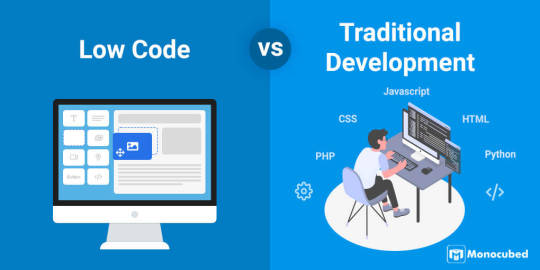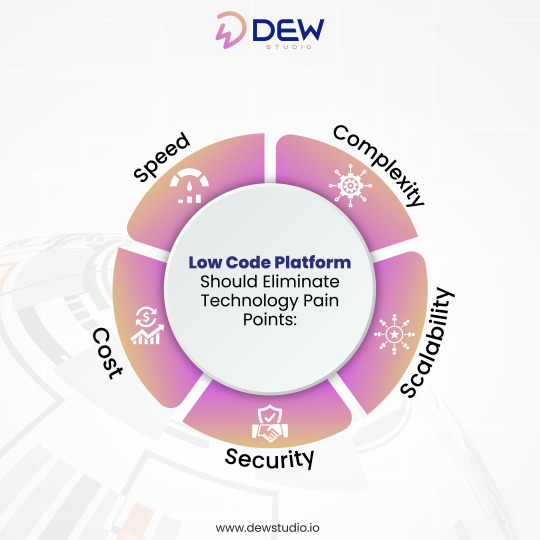#lowcode technologies
Explore tagged Tumblr posts
Text
Low-code development platforms have revolutionized app development, allowing businesses and individuals to create applications faster and more efficiently. By choosing the right platform with Omnepresent Technologies and considering your project’s specific needs, you can harness the power of low-code development to bring your app ideas to life.
0 notes
Text
Enterprise Application Platform: Future Trends and Innovations
The Enterprise Application Platform (EAP) landscape is constantly evolving, driven by technological advancements and changing business needs. Understanding the future trends and innovations in this area is crucial for businesses looking to stay competitive and maximize the benefits of their EAP investments.

Key Future Trends
AI and Machine Learning (AI/ML) Integration: AI and ML are increasingly being integrated into EAPs to automate tasks, improve decision-making, and personalize user experiences.
Low-Code/No-Code Development: These platforms enable citizen developers to build and deploy applications quickly, reducing the reliance on traditional coding and accelerating digital transformation.
Cloud-Native Architecture: EAPs are increasingly being built on cloud-native architectures, leveraging microservices, containers, and serverless computing to improve scalability, flexibility, and resilience.
Edge Computing: Bringing processing closer to the data source, edge computing enables faster response times and improved performance for IoT devices and other edge applications.
Internet of Things (IoT) Integration: EAPs are becoming more adept at integrating with IoT devices, enabling businesses to collect and analyze data from a wider range of sources.
Microservices Architecture: This architectural style allows for the development of applications as a collection of small, independent services, improving flexibility and maintainability.
Serverless Computing: This model allows developers to build and run applications without managing servers, reducing operational overhead and improving scalability.
Enhanced Security: With increasing cyber threats, EAPs are incorporating advanced security features to protect sensitive business data and ensure compliance with industry regulations.
Impact on Businesses
These future trends will have a significant impact on businesses, enabling them to:
Automate complex processes: AI/ML will automate tasks that were previously done manually, freeing up employees for more strategic work.
Develop applications faster: Low-code/no-code platforms will accelerate the development and deployment of new applications.
Improve scalability and flexibility: Cloud-native architectures will allow businesses to scale their applications easily and adapt to changing demands.
Gain real-time insights: Edge computing and IoT integration will provide businesses with access to real-time data from a wider range of sources.
Enhance security: Advanced security features will protect sensitive business data and ensure compliance.
Conclusion
The future of Enterprise Application Platforms is exciting, with numerous innovations on the horizon. By understanding these trends and adopting the right technologies, businesses can transform their operations, improve efficiency, and achieve sustainable growth in the years to come.
Ai Auto code
AI Wave maker
Rapid low code application development platform
Low code platform Enterprise software for application development
Low code application development platform or Low code platform for application development
What is Low code app development platforms
Composable low code isvs
Java-based low code platform
Composable isvs
RAD studio-Rapid application development software platform
APAAS-application platform as a service
Cloud Low code application development platform
Legacy application modernization solutions
React-native cross-platform mobile application development platform
Compare Wavemaker vs Outsystems vs mendix vs power apps — low code alternatives and its pricing
New and fast application development platform
Rapid application development model or RAD model
Low-code for consumable Banking and financial Low-code platform solutions
Internal api vs external apis
Rapid application development vs SDLC Platform
Custom Enterprise low code application development platform
Legacy enterprise application Modernization Platform
Embedded banking and Finance, Low-Code and the Emerging Face of Adaptability
BAAS- Low code Banking as a service
Composable Low code banking solutions
Telecom low code platform
Alternative to Xamarin and Cordova
Wavemaker Low code
Legacy application modernization platform
Cross-Platform React Native Mobile App Development Platform
#technology#software#low code#lowcode#app#app development#business#low code application development platform#rad#reactnative
1 note
·
View note
Text
Building Your First App with No-Code Platforms
In today's fast-paced digital landscape, anyone can become a creator with the help of no-code platforms. You no longer need to know how to code to bring your ideas to life. With these tools, anyone from a busy entrepreneur to a curious hobbyist can create useful applications that solve real problems. This guide will walk you through the process of building your first app step by step, without writing any code.
No-code platforms let you design applications visually by using pre-built components and workflows. This approach can improve your workflow efficiency and save money. Below, we outline the steps to help you start your app development journey.
Understanding No-Code Platforms
No-code platforms enable users to create applications through graphical interfaces instead of traditional coding. This means you can drag and drop elements, design the look, and set up the logic all without writing a line of code.
Some of the most popular no-code platforms include:
Bubble: Great for web apps, it allows for a high level of customization, with more than 8,000 templates available.
Adalo: Focused on mobile apps, making it notably easy for beginners to create functional applications.
Airtable: It combines spreadsheet simplicity with powerful database capabilities, streamlining project management tasks.
AppGyver: Ideal for building mobile apps quickly, offering a user-friendly interface backed by impressive functionalities.
The convenience of no-code platforms means you can create apps tailored to your needs without learning complex coding languages.
Step 1: Define Your Idea
The cornerstone of your app development is a clear idea. To formulate your concept, consider these questions:
What specific problem is your app addressing?
Who is your intended audience?
Which features are crucial for your idea to become a reality?
Spend time fleshing out your concept. Consider using a mind map or outline to visualize and organize your thoughts. For example, if you want to create a budgeting app for students, determine essential features like expense tracking and budgeting tips.
Step 2: Choose the Right No-Code Platform
With many no-code platforms to choose from, pick one that suits your project's goals. Here are some factors to keep in mind:
Ease of Use: Select a platform that feels comfortable to navigate, especially if you're new to app development.
Features and Flexibility: Ensure the platform offers the functionalities you envision for your app, such as user logins or payment processing.
Integration Capabilities: Check if the platform can connect with other tools you plan to use, like email marketing software.
For instance, if you're creating a task management app, you might find Airtable or Bubble to be particularly helpful due to their organization features.

Step 3: Sketch Your Wireframe
Before diving into the actual build, create a wireframe to outline your app’s layout. A wireframe provides a visual guide for the user experience and interface and doesn't need to be perfect—just an initial layout showing how everything fits together.
You can use tools like Figma or even sketch it on paper. Visualize the main screens of your app. If, for example, your app is a recipe sharing platform, you might sketch a homepage with featured recipes, a search bar, and links to user profiles.
Step 4: Design Your App
With your wireframe in place, it's time to flesh out your app’s visual design. Most no-code platforms feature customizable templates, which streamline the design process.
Here are principles to guide your design:
Consistency: Keep the color scheme and font style uniform throughout your app to create a cohesive look.
Simplicity: Avoid clutter. A clean design makes navigation intuitive.
Accessibility: Ensure that users with disabilities can adequately use your app. Implement features like alt text for images and proper contrast between text and background.
If you're designing an ecommerce app, for instance, make sure that product pages are clear and concise for a better shopping experience.
Step 5: Build Your App
Once your design is ready, it’s time to build your app using your chosen no-code platform. Begin by dragging and dropping your components.
Pay attention to these aspects:
User Authentication: If your app has user accounts, set up secure login systems to manage access.
UI Elements: Incorporate buttons, sliders, and forms to enhance user interaction.
Database Connection: Link your app to a database if it needs to store or retrieve user-generated content. Platforms like Airtable offer built-in database tools.
Utilize tutorials and community forums to troubleshoot any issues that arise.
Step 6: Iterate and Test
After building a prototype, it is vital to test your app and iterate based on user feedback. Get insights from friends, family, or potential users who can provide unbiased opinions.
Consider the following areas during your testing phase:
Functionality: Confirm that all features perform as intended.
User Experience: Gather feedback on the ease of navigation and clarity of information.
Performance: Measure how quickly your app responds. Statistically, a one-second delay can yield a 7% reduction in conversions.
Improving your app is an ongoing process, so be ready to adapt based on feedback.

Step 7: Launch Your App
When you're confident about your app's performance, it’s time to launch. Depending on your app's nature, this could involve publishing it on websites, app stores, or distributing it personally for beta testing.
To optimize your launch:
Create Buzz: Leverage social media, email promotions, and your website to build anticipation.
Gather Feedback: Encourage early users to leave reviews or suggestions after trying out your app.
Plan for Updates: Stay prepared for updates based on initial user feedback.
The hard work leads to this moment, and your launch is just the beginning of your app's journey.
Step 8: Maintain and Update Your App
After launching, prioritize maintaining and updating your app. Analyze user feedback and analytics to pinpoint areas needing attention. Regular updates will keep your app functional and relevant in the ever-changing tech landscape.
Consider maintaining:
New Features: As your user base grows, you may want to implement features that enhance usability.
Bug Fixes: Regular checks guarantee your app operates smoothly.
User Engagement: Keep users informed about updates to foster loyalty and interest.
Your dedication to ongoing improvement will drive your app’s long-term success.
The Journey Ahead
Creating your first app without writing code is a rewarding venture. With no-code platforms, your creativity can shine without technical limitations.
By following this guide—defining your idea, selecting the right platform, and iterating based on feedback—you can transform your concepts into functional applications. As the no-code movement grows, more individuals have the opportunity to step into the world of app development.
Start your journey today, and imagine the possibilities ahead as you watch your app positively impact its users.
#NoCode#AppDevelopment#Entrepreneurship#Startups#AI#Technology#Innovation#Business#Automation#DigitalTransformation#Productivity#SoftwareDevelopment#Bubble#Adalo#Airtable#LowCode#TechTrends#WebApps#MobileApps#FutureOfWork
0 notes
Text
Low-Code AI/ML Integration: A Step-by-Step Guide

Introduction
In today’s rapidly evolving digital landscape, tapping into the power of Artificial Intelligence (AI) and Machine Learning (ML) has become essential for businesses that want to stay ahead of the competition. Yet, the traditional methods of implementing these technologies usually come with a steep learning curve and require a lot of coding expertise. This can be intimidating, especially for many developers who may not have extensive programming backgrounds.
The good news is that low-code platforms are stepping in to make this process a lot easier. They allow both experienced Python developers and newcomers to coding to effectively use AI and ML capabilities without the usual complexity. In this blog, we’ll break down the steps needed to integrate AI and ML into your applications using low-code solutions, making it simple and approachable.
Understanding Low-Code Development
At its core, low-code development empowers users to create applications through visual interfaces and minimal hand-coding. This means faster development times and less reliance on specialized programming skills, making it accessible to a broader audience. According to Gartner, more than 65% of all application development is expected to be carried out using low-code platforms by 2024.
Who Should Care?
1) Python Developers: If you’re already familiar with Python, you can enhance your skill set by diving into low-code integration without needing to overhaul your methods.
2) Low-Code Developers: For those keen on adding advanced features to applications quickly, low-code platforms provide a fast track to integrating AI and ML capabilities.
The Importance of AI/ML Integration
Implementing AI and ML into your applications can lead to dramatic improvements in user experiences and operational efficiencies. McKinsey & Company has indicated that businesses investing in AI could see profitability increases of up to 122%. With low-code platforms, you can swiftly deploy ML models, derive insights, and provide personalized user engagement.
Real-World Examples:
1) Healthcare Using AI for predictive analytics to improve patient outcomes.
2) Finance Implementing fraud detection systems to protect sensitive information.
3) Retail Developing personalized marketing strategies to enhance customer engagement.
"AI is the new electricity," says Andrew Ng, a leading voice in AI. This statement underscores the transformative power of AI when integrated effectively.
Steps to Integrate AI/ML with Low-Code Platforms
1. Choose the Right Low-Code Platform
Look for platforms that are user-friendly and scalable while offering AI/ML features. Options like Argos STU, Argos PAM, and Argos Supervisor and Argos POT SDK are worth exploring.
2. Prepare Your Data
Data is fundamental to any AI/ML application. Collect, clean, and prepare your data using the built-in data connectors that many low-code platforms offer.
3. Select and Build Your Model
Utilize pre-built models provided by the low-code platform or import your own. Choose the appropriate model based on your application’s needs, whether it’s for regression, classification, or clustering tasks.
4. Integrate Your AI/ML Model
Leverage the platform’s visual builder to integrate your AI/ML model into your application’s workflow effortlessly. Many low-code options simplify API creation and connectivity with other services.
5. Testing and Deployment
Conduct thorough testing to ensure that your AI/ML components work as intended. Low-code platforms typically allow for easy updates, enabling quick iterations based on feedback.
Key Considerations and Challenges
While the benefits of low-code AI/ML integration are compelling, keep in mind some challenges:
1) Data Privacy and Security With increasing regulatory scrutiny it’s crucial to handle sensitive data responsibly.
2) Model Limitations While pre-built models can simplify the process, they may not always suit your specific needs, necessitating some customization, which might still involve traditional coding.
Addressing these considerations is vital to ensure a successful integration.
Conclusion
Integrating AI and ML into your applications using low-code platforms is an exciting opportunity for developers to innovate and elevate their projects. As these platforms advance, they make the integration process more accessible than ever before. So, why not dive in and start experimenting with Argos Labs low-code AI/ML integration today?
Want to learn more? Subscribe to our blog for ongoing insights on low-code technologies and tips on how to revolutionize your development approach!
Argos Labs Low-Code AI/ML Integration Platform
If you’re searching for a user-friendly low-code platform tailored for AI and ML integration, look no further than Argos Labs. Their solutions empower users to unlock the potential of AI without extensive coding requirements, enabling you to focus on innovation and growth.
By following this guide, you’ll not only enhance your understanding of low-code AI/ML integration but also gain practical insights you can apply immediately. Embrace the future of development and harness the power of low-code today!
0 notes
Text
Low-Code/No-Code Website Development for Busy Entrepreneurs:

Low-Code/No-Code Website Development for Busy Entrepreneurs: Build, Launch, Thrive (Without Writing Code!)
Do you dream of a professional website for your business but lack the time or budget to hire a developer? You're not alone. Busy entrepreneurs often find themselves strapped for resources when it comes to establishing an online presence. But fear not! The low-code/no-code development revolution is here to empower you to build a stunning website without ever touching a line of code.
Keywords: low-code website development, no-code website development, website for entrepreneurs, build a website, DIY website
Corewaylabs, Guwahati: Learn Digital Marketing, AI, Web & App Design

In this blog post, we'll explore the magic of low-code/no-code platforms and how they can be the perfect solution for busy entrepreneurs:
Unleash Your Inner Designer: Forget complex coding languages. Low-code/no-code platforms offer intuitive drag-and-drop interfaces that let you design beautiful and functional websites visually. Choose from a vast library of pre-built templates and customize them to match your brand identity.
Focus on What Matters: No more wrestling with technical jargon. Low-code/no-code platforms handle the back-end complexities, freeing you to focus on what matters most – crafting compelling content and building a successful business.
Cost-Effective and Time-Saving: Hiring a developer can be expensive and time-consuming. Low-code/no-code platforms offer a cost-effective and efficient way to get your website up and running quickly. Many platforms even offer free trials or affordable pricing plans to suit your startup budget.
Built-in Scalability: As your business grows, your website needs to grow with it. Low-code/no-code platforms often offer scalability features, allowing you to add new functionalities and features as your needs evolve.
But is low-code/no-code right for your business? Here are some things to consider:
Website Complexity: If you envision a highly customized website with intricate features, a traditional developer might be a better choice. However, low-code/no-code platforms are becoming increasingly sophisticated and can handle a surprising range of website types.
Technical Comfort Level: Do you have a basic understanding of website design principles? Low-code/no-code platforms are user-friendly, but some technical know-how can be helpful.
Ready to take the plunge? Here are some popular low-code/no-code platforms to explore:
Wix
Squarespace
Webflow
Bubble
Remember, a website is a crucial asset for any business, and with low-code/no-code development, there's no excuse to wait. Take control of your online presence today!
Call to Action: Want to learn more about how low-code/no-code development can help your business thrive? Visit our website at Coreway Labs for more details, tutorials, and consultations!
1 note
·
View note
Text
Looking for a way to create market-ready, consumer-friendly applications in no time? AI-led low code solutions hold the key to your success. Check out the link to read more : https://fournxt.com/blog/unlocking-the-potential-of-artificial-intelligence-in-app-development-using-ai-enabled-low-code/
#lowcode#FutureNxt#FourNxt#tech#technology#softwaresolutions#techsolutions#TechCompany#app#apps#applicationdevelopment#blog#readtheblog#lowcodeplatform#lowcodedevelopment#enterprise#business#artificialintelligence#ai#uae#qatar#oman#dubai#saudi arabia
0 notes
Text

#lowcode#software#technology#trending#low code development#low code app development platform#low-code#low code
0 notes
Text
How Lowcode and Nocode Are Making AI More Accessible for Businesses

Artificial Intelligence (AI) is changing the way businesses operate—helping them cut costs, save time, and make smarter decisions. From small startups to large enterprises, companies around the world are exploring how AI can create more efficient and impactful operations.
But for many businesses, bringing AI into their work can feel overwhelming. It often requires technical teams, long timelines, and big investments. That’s where Lowcode and Nocode platforms come in.
What Are Lowcode and Nocode Tools?
Lowcode and Nocode (LCNC) platforms are tools that let people use technology—like AI—without needing to write complicated code. These platforms use easy, drag-and-drop features and ready-made templates, so even someone with no coding experience can build useful solutions.
Instead of hiring a full team of developers or data scientists, your existing team can start using AI to improve daily work.
Why More Businesses Are Using LCNC for AI
1. Easy to Use
You don’t need a tech background. With simple interfaces, anyone in your team can explore and use AI tools.
2. Faster Results
LCNC platforms help teams test ideas quickly and make changes without waiting on long development processes.
3. Cost-Effective
No need for expensive hires or long-term tech projects. You can get started with fewer resources.
4. Boosts Productivity
By using AI for tasks like data sorting, document processing, or customer support, your team can focus on more important work.
Where LCNC and AI Can Help
LCNC tools can be used across almost any part of a business:
Customer Support: Use AI chatbots to answer common questions.
HR: Help with resume screening and scheduling interviews.
Operations: Automate document handling or data entry.
Marketing: Analyze data and create quick reports.
Tips for Getting Started
If you’re thinking about using Lowcode and Nocode tools to explore AI, here are a few tips:
Pick one small project to start—something simple but helpful.
Make sure your data is clean and organized.
Have someone check security and privacy for any tools you use.
Train your team so they feel confident using the tools.
Let’s Make AI Work for You
You don’t need to be a developer to use AI anymore. With Lowcode and Nocode tools, businesses of all kinds can tap into the power of AI—easily, quickly, and affordably.
Want help getting started with Lowcode and Nocode for your business? 👉 Contact us today to see how we can help you take the next step.
0 notes
Text
Low-Code Developers in Singapore: Transforming Digital Solutions with Speed and Efficiency

Introduction
The rise of low-code development has revolutionized the way businesses create applications, allowing for faster deployment and reduced dependency on traditional programming. In Singapore, a global hub for technology and innovation, low-code developers are in high demand as companies embrace digital transformation. This article explores the role of low-code developers in Singapore, their impact on businesses, and the future of low-code development in the region.
What is Low-Code Development?
Low-code development is an approach that minimizes manual coding by using visual interfaces, drag-and-drop functionality, and pre-built components to create applications. This allows developers to focus on logic and functionality rather than writing extensive lines of code. Popular low-code platforms include OutSystems, Mendix, Microsoft Power Apps, and Appian.
Why is Low-Code Development Gaining Popularity in Singapore?
Singapore’s digital landscape is evolving rapidly, driven by government initiatives, smart city projects, and a thriving startup ecosystem. Several factors contribute to the increasing demand for low-code development in the country:
Speed and Efficiency: Traditional software development can take months, whereas low-code platforms enable rapid prototyping and deployment.
Cost-Effectiveness: Businesses can reduce development costs by leveraging low-code tools instead of hiring large teams of developers.
Bridging the IT Talent Gap: With a shortage of skilled developers, low-code platforms allow non-technical users (citizen developers) to build applications with minimal coding knowledge.
Agility in Digital Transformation: Companies can quickly adapt to market changes, automate workflows, and improve customer experiences.
Government Support: Initiatives like Singapore’s and Industry Transformation Maps (ITMs) encourage digitalization, fueling the need for low-code solutions.
The Role of Low-Code Developers in Singapore
Lowcode developers in Singapore are transforming industries by building applications that streamline operations and enhance user experience. Their key responsibilities include:
Application Development: Using low-code platforms to design, develop, and deploy applications efficiently.
Process Automation: Creating workflows that automate repetitive tasks and improve productivity.
Integration with Existing Systems: Ensuring seamless connectivity between new applications and legacy systems or APIs.
Customization and Scalability: Enhancing applications with custom logic, security measures, and scalability features.
Training and Collaboration: Working with citizen developers and IT teams to maximize the potential of low-code solutions.
Industries Benefiting from Low-Code Development in Singapore
Various sectors in Singapore are leveraging low-code platforms to drive innovation and efficiency:
Finance & Banking: Automating loan processing, fraud detection, and customer onboarding.
Healthcare: Developing patient management systems and telemedicine solutions.
Retail & E-commerce: Creating personalized shopping experiences and inventory management tools.
Education: Building e-learning platforms and student management systems.
Government & Public Services: Enhancing digital services and citizen engagement platforms.
Challenges Faced by Low-Code Developers in Singapore
While low-code development offers numerous advantages, developers face some challenges:
Customization Limitations: Some complex applications require custom coding beyond the capabilities of low-code platforms.
Security Concerns: Ensuring data protection and compliance with regulatory standards.
Scalability Issues: Managing performance and scalability for enterprise-level applications.
User Adoption: Encouraging organizations to embrace low-code development as a viable alternative to traditional coding.
The Future of Low-Code Development in Singapore
The low-code development market in Singapore is expected to grow exponentially as businesses continue to prioritize digital transformation. Key trends shaping the future include:
AI-Driven Development: Integration of AI and machine learning into low-code platforms for enhanced automation.
Hyperautomation: Combining low-code with RPA (Robotic Process Automation) to automate end-to-end business processes.
Low-Code for Enterprise Applications: Increased adoption by large enterprises to build complex, scalable applications.
Citizen Development Movement: More businesses will empower non-technical employees to create applications using low-code platforms.
Conclusion
Low-code developers in Singapore are playing a crucial role in accelerating digital innovation across industries. With the growing demand for faster, cost-effective, and scalable solutions, businesses are increasingly turning to low-code platforms to stay competitive. As the technology evolves, low-code development will continue to shape the future of application development in Singapore, making it an essential skill for developers and organizations alike.
For more details, visit us:
Lowcode Software Engineers in Singapore
Pega Developers in Singapore
Appian Developers in Singapore
#Software Testing Services in Singapore#Salesforce Developers in Singapore#Microsoft Developers in Singapore
0 notes
Text
Servicenow/LowCode Manager(Global Pharma company)
Primary Skills: 1. Proven experience 12-15 years total experience in developing, designing and delivering solutions on platform like ServiceNow, Microsoft Technology stacks. 2. Experienced in managing development project across all phas… Apply Now
0 notes
Text
The rise of low-code and no-code platforms is poised to revolutionize the industrial manufacturing sector. By seamlessly integrating IoT and facilitating rapid digital transformation, these tools enable manufacturers to swiftly adapt to evolving technologies and market demands. Embracing these platforms isn't just a trend; it's a strategic imperative for future industry leaders. Dive deeper into this digital transformation with OmnePresent technologies in our blog, uncovering insights for navigating the evolving manufacturing landscape.
0 notes
Text
Optimizing Business Operations with Enterprise Platforms
In today's competitive business landscape, organizations are constantly seeking ways to enhance efficiency, reduce costs, and accelerate innovation. Enterprise platforms have become indispensable tools for achieving these goals, offering a unified and integrated environment for managing a wide range of business applications.
Here's an image illustrating the concept of Optimizing Business Operations with Enterprise Platforms:

Key Benefits of Enterprise Platforms
Enterprise platforms offer a multitude of advantages, impacting nearly every facet of an organization:
1. Enhanced Efficiency and Productivity
Automation: Enterprise platforms automate repetitive tasks and workflows, reducing manual effort and minimizing errors. This allows employees to focus on more strategic and value-added activities, boosting overall productivity.
Streamlined Processes: By consolidating disparate systems and processes, enterprise platforms streamline operations, eliminating redundancies and improving resource allocation.
Improved Collaboration: Centralized communication tools, document-sharing capabilities, and project management features facilitate seamless collaboration across departments and teams.
2. Cost Reduction
Lower Development and Maintenance Costs: Enterprise platforms simplify application development and management, reducing the costs associated with building and maintaining software.
Reduced Infrastructure Needs: Many modern enterprise platforms leverage cloud-native architectures, leading to lower infrastructure costs and improved resource utilization.
Operational Savings: The increased efficiency and automation driven by enterprise platforms translate directly into reduced operational expenses.
3. Data-Driven Insights and Decision-Making
Centralized Data: Enterprise platforms provide a centralized repository for business data, ensuring convenient access to crucial information across the organization.
Advanced Analytics: Powerful analytics tools enable organizations to extract actionable insights from data, facilitating predictive modeling and real-time reporting.
Informed Decisions: With real-time access to comprehensive and accurate data, business leaders can make more informed and timely decisions.
4. Scalability and Flexibility
Adaptability to Change: The modular nature of enterprise platforms enables businesses to quickly adapt to changing market conditions, regulatory requirements, and customer demands.
Scalability: Enterprise platforms are designed to be scalable, allowing organizations to easily expand their application landscape as their business grows and evolves.
Support for Diverse Workloads: Whether it's a transactional system, a data analytics platform, or a customer-facing application, enterprise platforms can support a wide range of workloads and business requirements.
5. Improved Customer Experience
Personalized Interactions: By leveraging customer data, enterprise platforms enable organizations to personalize interactions and tailor products or services to individual preferences.
Enhanced Customer Service: Streamlined processes and improved communication allow for faster and more effective responses to customer inquiries and issues.
Increased Customer Satisfaction: By delivering exceptional customer experiences, organizations can foster loyalty and build long-term relationships.
Essential Features of an Enterprise Platform
When selecting an enterprise platform, consider these crucial features:
Integration Capabilities: Robust connectors and APIs for seamless integration with existing systems.
Low-Code/No-Code Capabilities: Empowering business users to build and modify applications with minimal coding.
Scalability and Performance: Ability to handle increasing workloads and user demands.
Security Features: Comprehensive security measures to protect sensitive data and applications.
Analytics and Reporting: Tools for monitoring application performance and gaining insights from data.
Cloud-Native Architecture: Leveraging cloud benefits for scalability, resilience, and cost-effectiveness.
User-Friendly Interface: Intuitive tools for developers and administrators.
Conclusion
In the era of digital transformation, enterprise platforms are no longer a luxury but a strategic imperative. By providing a unified, scalable, and efficient environment for managing business applications, enterprise platforms empower organizations to optimize operations, accelerate innovation, reduce costs, and ultimately achieve sustainable growth. Investing in the right enterprise platform can unlock significant operational efficiencies, allowing businesses to thrive in an increasingly competitive landscape.
Read More
Ai Auto code
AI Wave maker
Rapid low code application development platform
Low code platform Enterprise software for application development
Low code application development platform or Low code platform for application development
What is Low code app development platforms
Composable low code isvs
Java-based low code platform
Composable isvs
RAD studio-Rapid application development software platform
APAAS-application platform as a service
Cloud Low code application development platform
Legacy application modernization solutions
React-native cross-platform mobile application development platform
Compare Wavemaker vs Outsystems vs mendix vs power apps — low code alternatives and its pricing
New and fast application development platform
Rapid application development model or RAD model
Low-code for consumable Banking and financial Low-code platform solutions
Internal api vs external apis
Rapid application development vs SDLC Platform
Custom Enterprise low code application development platform
Legacy enterprise application Modernization Platform
Embedded banking and Finance, Low-Code and the Emerging Face of Adaptability
BAAS- Low code Banking as a service
Composable Low code banking solutions
Telecom low code platform
Alternative to Xamarin and Cordova
Wavemaker Low code
Legacy application modernization platform
Cross-Platform React Native Mobile App Development Platform
#technology#software#low code#lowcode#app#app development#business#low code application development platform#rad#reactnative
1 note
·
View note
Video
youtube
Improve your business outcomes by extending your existing lines of business with Power Platform. We’ll guide your team on how to get more out of your legacy technology investments by creating simplified workflows and automating processes without the need for complex code. #lowcode #automation #productivity
0 notes
Text

🌟 Accelerate Your Career with Power Apps & Power Automate!
💻 Join our new online training batch and master Microsoft’s no-code/low-code tools.
✍️Join Now: https://meet.goto.com/449344061
👉Attend Online #NewBatch On #Power_Apps_and_Power_Automation by Mr.Rajesh.
📅Batch on: 13th February 2025 @ 8:00 AM IST.
📲Contact us: +91 7032290546
🟢WhatsApp: https://wa.me/c/917032290546
🌐Blog: https://visualpathblogs.com/category/powerapps-powerautomate/
🌐Visit: https://www.visualpath.in/online-powerapps-training.html
🔥 What You’ll Gain:
✅ Build robust apps with Power Apps – no coding required
✅ Automate workflows and improve efficiency with Power Automate
✅ Integration skills with Microsoft’s ecosystem
✅ Hands-on training with real-time projects
#Visualpath#powerplatform#microsoft#powerbi#powerapps#dynamics#powerautomate#msdyn#technology#sharepoint#ai#canvasapp#digitaltransformation#erp#students#bangalore#hyderabad#modeldrivenapp#software#eductaion#TechSkills#trending#trendingcourses#TechCourses#ITTraining#PowerBI#nocode#lowcode
1 note
·
View note
Text
𝟓 𝐋𝐨𝐰-𝐂𝐨𝐝𝐞 𝐀𝐈/𝐌𝐋 𝐌𝐲𝐭𝐡𝐬 𝐃𝐞𝐛𝐮𝐧𝐤𝐞𝐝: 𝐒𝐞𝐩𝐚𝐫𝐚𝐭𝐢𝐧𝐠 𝐅𝐚𝐜𝐭 𝐟𝐫𝐨𝐦 𝐅𝐢𝐜𝐭𝐢𝐨𝐧

As a pioneer in low-code AI/ML integration, ARGOS LABS - Low Code AI/ML Integration Platform clears up common misconceptions hindering businesses from embracing this revolutionary technology. 𝐌𝐲𝐭𝐡 𝟏 Low-Code AI/ML is Only for Non-Technical Users 𝐑𝐞𝐚𝐥𝐢𝐭𝐲 Low-code platforms empower both citizen developers and technical experts to streamline AI/ML integration. 𝐌𝐲𝐭𝐡 𝟐 Low-Code AI/ML Compromises on Security 𝐑𝐞𝐚𝐥𝐢𝐭𝐲 Reputable low-code platforms, like Argos Labs, prioritize enterprise-grade security and compliance. 𝐌𝐲𝐭𝐡 𝟑 Low-Code AI/ML Limits Customization 𝐑𝐞𝐚𝐥𝐢𝐭𝐲: Argos Labs' platform offers seamless integration with popular libraries and frameworks, ensuring flexibility. 𝐌𝐲𝐭𝐡 𝟒 Low-Code AI/ML is Only for Small-Scale Projects 𝐑𝐞𝐚𝐥𝐢𝐭𝐲: Low-code AI/ML enables scalable, enterprise-wide automation and innovation., 𝐌𝐲𝐭𝐡 𝟓 Low-Code AI/ML Replaces Human Experts 𝐑𝐞𝐚𝐥𝐢𝐭𝐲: Low-code AI/ML augments human expertise, freeing professionals to focus on strategic decision-making. 𝐁𝐫𝐞𝐚𝐤 𝐅𝐫𝐞𝐞 𝐟𝐫𝐨𝐦 𝐌𝐢𝐬𝐜𝐨𝐧𝐜𝐞𝐩𝐭𝐢𝐨𝐧𝐬! 𝐊𝐞𝐲 𝐓𝐚𝐤𝐞𝐚𝐰𝐚𝐲𝐬 🧿 Enhanced efficiency 🧿 Improved accuracy 🧿 Increased scalability 🧿 Faster time-to-market 🧿Strategic decision-making Discover how Argos Labs low-code AI/ML integration platform transforms businesses.
1 note
·
View note
Video
youtube
Improve your business outcomes by extending your existing lines of business with Power Platform. We’ll guide your team on how to get more out of your legacy technology investments by creating simplified workflows and automating processes without the need for complex code. #lowcode #automation #productivity
0 notes